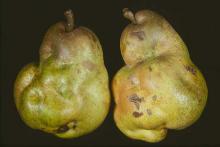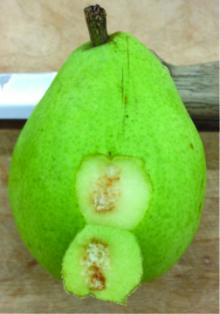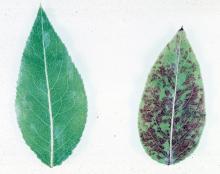See:
Apple (Malus spp.) - Latent Virus Diseases
Cause A virus disease that is graft transmissible. There is no indication that an insect vector spreads the virus. The disease is sporadic in the Pacific Northwest, apparently in conjunction with specific climatic conditions. Cultivars react differently; only Bosc shows all types of symptoms. Cultivars showing mild symptoms include Clairgeau, Old Home, Packham's Triumph, and Waite. Occasionally, the cultivar Packham's Triumph fruit show severe symptoms. Studies suggest that the disease is associated with the latent apple stem pitting virus and apple chlorotic leaf spot virus and with the diseases Apple green crinkle and Pear vein yellows
Symptoms Under specific climatic conditions, the disease appears in noncertified 'Bosc', to some extent in 'Anjou', and occasionally in 'Comice' and 'Bartlett', causing a fruit pitting and deformity. In 'Bosc', a roughened bark condition may also accompany the pitting. There is excessive stone-cell development below the pits in the skin. Pitting may be severe in 'Anjou' but is less common than in 'Bosc'.
Light or moderate fruit symptoms may be confused with pitting from tarnished-plant bug damage, stink bugs, boron deficiency, or corky spot. Stink bug feeding damage is a depressed blemish with a puncture site that is always visible in the center leading to a brown cork-like area in the flesh.
Cultural control
- Remove and replace with a tree that has been tested and found free of all known viruses.
- Establish new plantings only with certified virus-tested trees.
References Leone, G., Lindner, J.L., van der Meer, F.A., Scheon, C.D., and Jongedijk, G 1998. Symptoms on apple and pear indicators after back transmission from Nicotiana occidentalis confirm the identity of apple stem pitting virus with pear vein yellows virus. Acta Horticulturae 472:61-65.
Milbrath, J.A. 1966. Stony Pit of Pear in Oregon. Oregon Agricultural Experiment Station Technical Bulletin 93.





